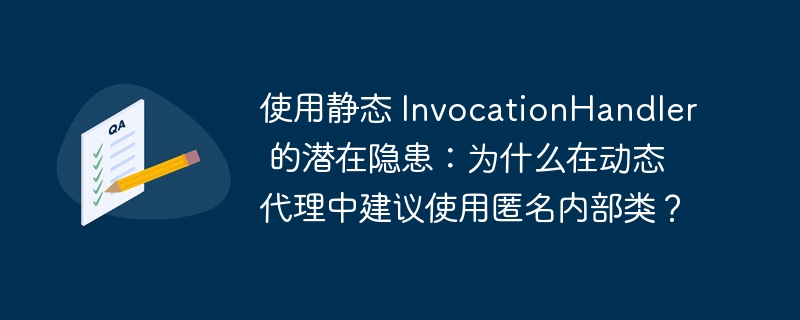使用静态 InvocationHandler 的潜在隐患:为什么在动态代理中建议使用匿名内部类?
时间:2024-11-03 13:12:47 235浏览 收藏
本篇文章向大家介绍《使用静态 InvocationHandler 的潜在隐患:为什么在动态代理中建议使用匿名内部类?》,主要包括,具有一定的参考价值,需要的朋友可以参考一下。

动态代理中的静态 invocationhandler
在使用 jdk 动态代理时,某些场景需要在 invocationhandler 中使用静态方法。然而,这种做法可能会带来潜在的隐患。
以下是使用静态方法的示例代码:
class myinvocationhandler implements invocationhandler {
private static service targetservice;
@override
public object invoke(object proxy, method method, object[] args) throws throwable {
return null;
}
public static service getproxyservice(service target) {
targetservice = target;
classloader contextclassloader = thread.currentthread().getcontextclassloader();
class<?>[] interfaces = targetservice.getclass().getinterfaces();
return (service) proxy.newproxyinstance(contextclassloader, interfaces, new myinvocationhandler());
}
}使用静态方法的潜在隐患在于:
- 线程安全问题:静态方法是全局可访问的,无法确保在多线程环境下的线程安全。
- 资源泄漏:静态引用会一直持有 targetservice 对象,即使代理对象已失效,targetservice 也会一直存在内存中,可能导致内存泄漏。
- 不灵活:静态方法不能动态修改 targetservice 对象,限制了动态代理的灵活性。
因此,推荐使用匿名内部类来实现 invocationhandler,如下所示:
Service proxyInstance = (Service) Proxy.newProxyInstance(target.getClass().getClassLoader(),
target.getClass().getInterfaces(), new InvocationHandler() {
@Override
public Object invoke(Object proxy, Method method, Object[] args) throws Throwable {
if ("add".equals(method.getName())) {
System.out.println("HELLOIDEA");
}
return null;
}
});今天关于《使用静态 InvocationHandler 的潜在隐患:为什么在动态代理中建议使用匿名内部类?》的内容介绍就到此结束,如果有什么疑问或者建议,可以在golang学习网公众号下多多回复交流;文中若有不正之处,也希望回复留言以告知!
相关阅读
更多>
-
501 收藏
-
501 收藏
-
501 收藏
-
501 收藏
-
501 收藏
最新阅读
更多>
-
212 收藏
-
111 收藏
-
316 收藏
-
477 收藏
-
333 收藏
-
177 收藏
-
436 收藏
-
488 收藏
-
309 收藏
-
249 收藏
-
396 收藏
-
106 收藏
课程推荐
更多>
-

- 前端进阶之JavaScript设计模式
- 设计模式是开发人员在软件开发过程中面临一般问题时的解决方案,代表了最佳的实践。本课程的主打内容包括JS常见设计模式以及具体应用场景,打造一站式知识长龙服务,适合有JS基础的同学学习。
- 立即学习 543次学习
-

- GO语言核心编程课程
- 本课程采用真实案例,全面具体可落地,从理论到实践,一步一步将GO核心编程技术、编程思想、底层实现融会贯通,使学习者贴近时代脉搏,做IT互联网时代的弄潮儿。
- 立即学习 516次学习
-

- 简单聊聊mysql8与网络通信
- 如有问题加微信:Le-studyg;在课程中,我们将首先介绍MySQL8的新特性,包括性能优化、安全增强、新数据类型等,帮助学生快速熟悉MySQL8的最新功能。接着,我们将深入解析MySQL的网络通信机制,包括协议、连接管理、数据传输等,让
- 立即学习 500次学习
-

- JavaScript正则表达式基础与实战
- 在任何一门编程语言中,正则表达式,都是一项重要的知识,它提供了高效的字符串匹配与捕获机制,可以极大的简化程序设计。
- 立即学习 487次学习
-

- 从零制作响应式网站—Grid布局
- 本系列教程将展示从零制作一个假想的网络科技公司官网,分为导航,轮播,关于我们,成功案例,服务流程,团队介绍,数据部分,公司动态,底部信息等内容区块。网站整体采用CSSGrid布局,支持响应式,有流畅过渡和展现动画。
- 立即学习 485次学习
